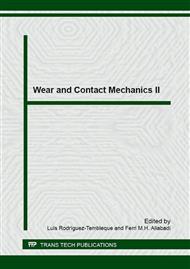[1]
G. Wautelet and J. -P. Ponthot: Key Engineering Materials Vol. 618 (2014), pp.1-22.
Google Scholar
[2]
G. Zavarise and L. De Lorenzis: International Journal for Numerical Methods in Engineering Vol. 79(4) (2009), pp.379-416.
Google Scholar
[3]
T. A. Laursen: Computational Contact and Impact Mechanics: Fundamentals of Modeling Interfacial Phenomena in Nonlinear Finite Element Analysis (Springer-Verlag, Berlin Heidelberg 2002).
Google Scholar
[4]
P. Wriggers: Computational Contact Mechanics (Springer-Verlag, Berlin Heidelberg 2006).
Google Scholar
[5]
R. L. Taylor and P. Papadopoulos, in: Nonlinear Computational Mechanics, edited by P. Wriggers and W. Wagner, Springer-Verlag, Berlin (1991), pp.690-702.
Google Scholar
[6]
G. Zavarise and L. De Lorenzis, in: Trends in Computational Contact Mechanics, edited by G. Zavarise and P. Wriggers, volume 58 of Lecture Notes in Applied and Computational Mechanics, Springer-Verlag, Berlin Heidelberg (2011), pp.79-100.
DOI: 10.1007/978-3-642-22167-5
Google Scholar
[7]
D. -T. Nguyen: PhD thesis, University of Liège (2014).
Google Scholar
[8]
G. Zavarise, P. Wriggers, E. Stein and B. A. Schrefler: International Journal for Numerical Methods in Engineering Vol. 35(4) (1992), pp.767-785.
Google Scholar
[9]
P. Wriggers and C. Miehe: Computer Methods in Applied Mechanics and Engineering Vol. 50(3) (1994), pp.739-759.
Google Scholar
[10]
S. Stupkiewicz: International Journal for Numerical Methods in Engineering Vol. 50(3) (2001), pp.739-759.
Google Scholar
[11]
J. Lengiewicz and S. Stupkiewicz : Computer Methods in Applied Mechanics and Engineering Vol. 205-208(0) (2012), pp.178-188.
DOI: 10.1016/j.cma.2010.12.020
Google Scholar
[12]
F. B. Belgacem, P. Hild and P. Laborde: Mathematical and Computer Modelling Vol. 28(4-8) (1998), pp.263-271.
Google Scholar
[13]
B. Wohlmuth: Computer Methods in Applied Mechanics and Engineering Vol. 38(3) (2000), pp.989-1012.
Google Scholar
[14]
M. A. Puso and T. A. Laursen: Computer Methods in Applied Mechanics and Engineering Vol. 193(6-8) (2004), pp.601-629.
Google Scholar
[15]
A. Popp, M. W. Gee and W. A. Wall: International Journal for Numerical Methods in Engineering Vol. 79(11) (2009), pp.1354-1391.
Google Scholar
[16]
J. C. Simo, P. Wriggers, and R. L. Taylor: Computer Methods in Applied Mechanics and Engineering Vol. 50(2) (1985), pp.163-180.
Google Scholar
[17]
P. Papadopoulos and R. L. Taylor: Computer Methods in Applied Mechanics and Engineering Vol. 94(3) (1992), pp.373-389.
Google Scholar
[18]
P. Papadopoulos and R. L. Taylor: Computers & Structures Vol. 46(6) (1993), pp.1107-1118.
Google Scholar
[19]
G. Zavarise and P. Wriggers: Mathematical and Computer Modelling Vol. 28(4-8) (1998), pp.497-515.
Google Scholar
[20]
J. Lengiewicz, J. Korelc and S. Stupkiewicz: International Journal for Numerical Methods in Engineering Vol. 85(10) (2011), pp.1252-1279.
Google Scholar
[21]
Information on http: /metafor. ltas. ulg. ac. be.
Google Scholar
[22]
K. J. Bathe: Finite Element Procedures (Prentice-Hall, New Jersey 1996).
Google Scholar
[23]
R. D. Cook, D. S. Malkus and M. E. Plesha: Concepts and applications of finite element analysis (John Wiley & Sons, third edition, 1989).
Google Scholar
[24]
T. Belytschko, B. Moran and W. K. Liu: Nonlinear Finite Elements for Continua and Structures (John Wiley & Sons, England 2000).
Google Scholar
[25]
P. Wriggers: Nonlinear Finite Element Methods (Springer-Verlag, Berlin Heidelberg 2008).
Google Scholar
[26]
J. -P. Ponthot: PhD thesis, University of Liège (1995).
Google Scholar
[27]
R. W. Ogden: Non-Linear Elastic Deformations (Dover Publications, New York 1997).
Google Scholar


